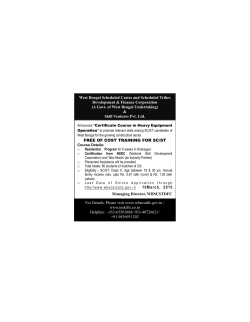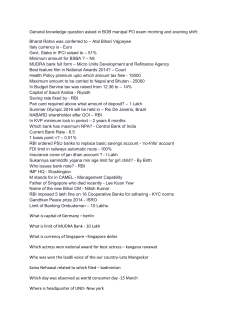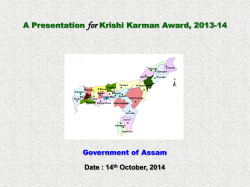
MF0012-Taxation Management
Winter-2015 Get solved assignments at nominal price of Rs.125 each. Mail us at: subjects4u@gmail.com or contact at 09882243490 Master of Business Administration - MBA Semester 3 MF0012-Taxation Management-4 Credits (Book ID: 1760) Assignment (60 Marks) Note: Answers for 10 marks questions should be approximately of 400 words. Each question is followed by evaluation scheme. Each Question carries 10 marks 6 X 10=60. Q1. Explain the objectives of tax planning. Discuss the factors to be considered in tax planning. Answer. Objectives of Tax Planning a. Reduction of tax liability by utilizing the benefits available in the tax laws. b. Informed and pragmatic financial decisions: A person adds the dimension of tax incidence in his decision-making on financial matters, and this helps him optimize his decisions. c. Multi-dimensional investment decisions: In a democratic welfare state like India the government requires substantial investment Q2. Explain the categories in Capital assets. Mr. C acquired a plot of land on 15th June, 1993 for 10,00,000 and sold it on 5th January, 2010 for 41,00,000. The expenses of transfer were 1,00,000. Mr. C made the following investments on 4th February, 2010 from the proceeds of the plot. a) Bonds of Rural Electrification Corporation redeemable after a period of three years, 12,00,000. b) Deposits under Capital Gain Scheme for purchase of a residential house 8,00,000 (he does not own any house). Compute the capital gain chargeable to tax for the AY2010-11. Answer. Categories of capital assets For taxation purposes, the capital assets have been, divided into (a) Short-term capital assets and (b) Long-term capital assets. Q3. Explain major considerations in capital structure planning. Write about the dividend policy and factors affecting dividend decisions. Answer. Major considerations in capital structure planning 1. Risk of two kinds, that is, financial risk and business risk: In the context of capital structure planning, financial risk is more relevant. Financial risk is of two types: (a) Risk of cash illiquidity: (b) Risk of variation in the earnings to equity shareholders in relation to expectation: Q4. X Ltd. has Unit C which is not functioning satisfactorily. The following are the details of its fixed assets: The written down value (WDV) is Rs. 25 lakh for the machinery, and Rs.15 lakh for the plant. The liabilities on this Unit on 31st March, 2011 are Rs.35 lakh. The following are two options as on 31st March, 2011: Option 1: Slump sale to Y Ltd for a consideration of 85 lakh. Option 2: Individual sale of assets as follows: Land Rs.48 lakh, goodwill Rs.20 lakh, machinery Rs.32 lakh, Plant Rs.17 lakh. The other units derive taxable income and there is no carry forward of loss or depreciation for the company as a whole. Unit C was started on 1st January, 2005. Which option would you choose, and why? Answer. Q5. Explain the Service Tax Law in India and concept of negative list. Write about the exemptions and rebates in Service Tax Law. Ans. Service Tax Law in India Service tax was introduced in India in 1994 by Chapter V of the Finance Act, 1994. It was imposed on an initial set of three services in 1994 and the scope of the service tax has since been expanded continuously by subsequent Finance Acts. There is no separate Service Tax Act, but all pronouncements relating to service tax are in the annual Finance Acts. Service Tax Rules, 1994 were enacted to begin with, and with notifications Q6. What do you understand by customs duty? Explain the taxable events for imported, warehoused and exported goods. List down the types of duties in customs. An importer imports goods for subsequent sale in India at $10,000 on assessable value basis. Relevant exchange rate and rate of duty are as follows: Calculate assessable value and customs duty. Answer. Customs Duty Customs duty is the duty imposed on goods imported into the country. In the years before globalization it was difficult to import goods on account of stiff duty rates and procedures, especially for less developed and. Taxable event for imported goods – The taxable event with respect to imports is the day of crossing of the ‘customs barrier’ and not the date on which goods land in India or enter its territorial waters. Taxable event for warehoused goods – The taxable event in case of warehoused goods is when goods are cleared from customs-bonded warehouse by submitting sub-bill of entry. Taxable event for exported goods – Taxable event arises for exported goods when the proper officer makes an order permitting clearance and loading of the goods for exportation under Winter-2015 Get solved assignments at nominal price of Rs.125 each. Mail us at: subjects4u@gmail.com or contact at 09882243490
© Copyright 2025









